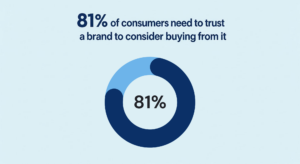What is Brand Perception and How to Improve it in 2025?
Did you know that 81% of customers need to trust a brand before buying from it?
This stat alone confirms one thing: brand perception is everything.
It’s the invisible force that influences consumer decisions, shapes customer loyalty, and drives business success.

But brand perspective isn’t just about having a catchy logo or a memorable tagline!
Yes, phrases like “Red Bull gives you wings” are ingrained in our minds! But trust us; there’s a lot more that’s gone into Red Bull’s iconic branding.
In this brand perception guide, we’ll reveal everything you need to know.
What is Brand Perception?
Brand perception is the collective impression that customers and the general public have about a brand.

It’s shaped by various factors, such as:
Customer experiences… marketing efforts… word-of-mouth… social media presence…
Essentially, it’s how people feel and think about your brand when they hear its name or see its logo.
Unlike brand identity, which is controlled by the company, brand perception is formed in the minds of consumers. It’s influenced by their interactions with your products or services, the values your brand represents, and the overall reputation you’ve built over time.
Why it is Important to have a Positive Brand Perception?
When was the last time you chose a product simply because you trusted the brand? A positive brand perception can make all the difference. Here’s why you need a brand perception strategy:
- Customer trust and loyalty – Imagine having customers who come back to you repeatedly because they trust your brand. This kind of loyalty can be a game-changer for your business.
- Competitive advantage – In a crowded marketplace, a strong brand perception sets you apart. It makes it easier to attract and retain customers compared to your competitors.
- Increased sales and revenue – Think about the brands you’re willing to pay a bit more for. You know they’re good, so you don’t mind spending a bit more! Positive perception can lead to higher sales and increased revenue.
- Enhanced brand equity – A great brand perception boosts your brand’s value, allowing you to command premium pricing and stand out as a leader in your industry.
- Crisis resilience – When things go wrong, brands with a positive perception bounce back quicker. Customers are more forgiving and supportive if they already have a positive view of your brand. Think about brands that have suffered data breaches, like Facebook and British Airways. Somehow, they’ve managed to bounce back, whereas lesser-known brands have had to close their doors altogether!
- Word-of-mouth marketing – Happy customers talk! They’re more likely to recommend your brand to others, providing you with powerful, organic marketing.
- Attracting talent – Think about the sort of business you’d want to work for. A well-known company with a great reputation is much more likely to attract top talent.
- Partnership opportunities – Positive perception opens doors. It makes other businesses want to partner with you, boosting your reach and influence.
How to Measure Brand Perception
As mentioned earlier, brand perception is all about how others view your brand. So, what brand perception research can you do to understand what other people think?
1. Surveys and Questionnaires
Why not ask your customers directly?
Distribute a brand perception survey via email, social media, or on your website. Ask about their satisfaction, product quality, and overall impression of your brand.
Some brand perception survey questions you can include:
a. On a scale of 1 to 10, how satisfied are you with our products/services?
b. How would you describe your overall impression of our brand?
- Positive
- Neutral
- Negative
- Please explain your choice.
c. What three words would you use to describe our brand?
2. Social Media Monitoring
Tools like Hootsuite and Brandwatch can track mentions and hashtags related to your brand.
You can also use sentiment analysis to reveal whether the chatter about your brand is positive, negative, or neutral.
3. Online Reviews and Ratings
What do your online reviews say about you? Tools like ReviewTrackers can collect reviews from multiple platforms, helping you see the big picture.
4. Brand Audits
How do you stack up against your competitors? A leading creative branding agency will conduct brand audits, such as competitor analysis. This can help you identify gaps and opportunities to enhance your perception.
Brand Perception Metrics
When measuring brand perception, it’s essential to use a variety of metrics to get a comprehensive understanding. Here are some examples.
- Net Promoter Score (NPS) – Measures customer loyalty by asking how likely customers are to recommend your brand to others.
- Customer Satisfaction (CSAT) – Assesses overall customer satisfaction with your products or services.
- Brand Awareness – Tracks the percentage of your target audience that is aware of your brand.
- Social Media Sentiment – Analyses the tone of social media mentions to determine if the sentiment is positive, negative, or neutral.
- Share of Voice – Compares your brand’s visibility in the market to that of your competitors.
- Customer Retention Rate – Measures the percentage of customers who continue to do business with your brand over a specific period.
Best Practices for Building a Strong Brand Perception
Building a strong brand perception takes time, strategy, and consistent effort.
1. Define Your Brand Identity
Your brand’s identity is the foundation of perception. Clearly define what your brand stands for.
Communicate your vision, mission, and values effectively.
Ensure your logo, colour scheme, and messaging are consistent across all platforms. Consistency helps reinforce your brand identity, making it easily recognisable and memorable.
2. Deliver Exceptional Customer Experiences
Customer experience plays a significant role in shaping brand perception.
Think about your last positive customer service experience. How did it make you feel about the brand?
Strive to deliver exceptional service by training your staff to be helpful, knowledgeable, and responsive.
Personalise your interactions with customers, using their names and remembering their preferences.
Show appreciation for their loyalty, making each customer feel valued.
3. Engage with Your Audience
Engagement is key to building a connection with your audience.
Be active on social media, responding to comments and sharing relevant content.
Create valuable content that resonates with your audience, such as blogs, videos, and social media posts.
Your content should provide value, entertain, inform, and reflect your brand’s voice, fostering a deeper connection with your audience.
4. Collect and Act on Feedback
Feedback is a goldmine of insights. Regularly collect feedback from your customers through surveys and reviews.
Listen to their opinions and act on their suggestions.
This shows that you value their input and are committed to improving their experience.
Address negative feedback promptly and constructively, turning potential issues into opportunities to enhance your brand perception.
5. Build Strong Relationships
Building strong relationships with customers, partners, and influencers can boost your brand perception.
Foster partnerships that align with your brand values and can amplify your reach.
Collaborate with influencers who genuinely resonate with your brand, as their endorsement can significantly impact perception.
6. Maintain Transparency and Authenticity
In a world where consumers value honesty, maintaining transparency and authenticity is crucial. Be open about your business practices, values, and any challenges you face.
Authenticity builds trust and makes your brand more relatable.
Share your brand story, showcasing the people behind the brand and the journey you’ve been on.
Real-World Brand Perception Examples
Let’s take a look at some real-world brand perception examples. These brands have managed to capture the hearts and minds of their audiences, creating lasting impressions.
Apple
Think of Apple – what comes to mind? Sleek design, innovation, and premium quality, right? Apple has built its reputation on delivering cutting-edge technology with products like the iPhone, iPad, and MacBook.
Remember the “Think Different” campaign? It was all about celebrating creativity and individuality. This iconic campaign made people feel like part of a community that thinks outside the box.
And, what about Apple’s stores? Have you ever visited one? With knowledgeable staff and hands-on product displays, Apple stores are designed to let you explore and interact with their products in a way that’s both fun and informative.
Nike
Nike’s “Just Do It” – do you remember the first time you heard it? It’s iconic, right?
Nike’s partnerships with legends like Michael Jordan and Serena Williams have cemented its status as the top sports brand. These endorsements are more than just ads; they’re about inspiring greatness and showing what’s possible.
And, who can forget the “Dream Crazy” campaign with Colin Kaepernick? This bold move highlighted social issues and showed Nike as a brand that stands up for what it believes in, resonating deeply with its audience.
Starbucks
Starbucks has cultivated a perception of being the “third place” between home and work. This concept is reflected in their cosy store environments, friendly baristas, and personalised customer service.
The brand’s commitment to ethical sourcing and sustainability, such as their Coffee and Farmer Equity (C.A.F.E.) Practices, appeals to socially conscious consumers.
Starbucks’ loyalty program, Starbucks Rewards, enhances customer retention by offering personalised offers and incentives.
Their seasonal product offerings and consistent social media engagement keep the brand fresh and top-of-mind for consumers.
How to Create a Strong Brand Perception
Cultivating a strong brand perception is essential for business success. Here are the key takeaways to keep in mind:
- Consistency is crucial
Ensure your brand identity, messaging, and customer experience are consistent across all touchpoints.
- Deliver exceptional customer service
Positive interactions build trust and loyalty. Personalise your customer engagements and show appreciation for their business.
- Engage authentically
Connect with your audience through valuable content and active social media presence. Authentic engagement fosters deeper connections.
- Listen and adapt
Collect and act on customer feedback. Address concerns promptly and use insights to improve your offerings.
- Stay true to your values
Be transparent and authentic in your business practices. A strong brand perception is built on trust and integrity.
Ready to start shaping your brand’s future? The journey begins today. Contact Appnova and let’s get working on your brand design strategy together!
Subscribe To Us
Our Services
Categories
Subscribe To Us
Contributors
Categories

This website uses cookies so that we can provide you with the best user experience possible. Cookie information is stored in your browser and performs functions such as recognising you when you return to our website and helping our team to understand which sections of the website you find most interesting and useful. Third party cookies such as Google Analytics is also used on this site to provide analytics in order to better understand the user engagement on our site.
You can adjust all of your cookie settings by navigating the tabs on the left hand side.
Strictly Necessary Cookie should be enabled at all times so that we can save your preferences for cookie settings.
If you disable this cookie, we will not be able to save your preferences. This means that every time you visit this website you will need to enable or disable cookies again.







0.Comments